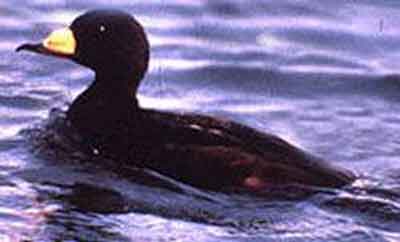Melanitta nigra (*) Cladus: Eukaryota Name Melanitta nigra (Linnaeus, 1758) References * Syst.Nat.ed.10 p.123 Vernacular names The Common Scoter (Melanitta nigra) is a large sea duck, 43-54 cm in length, which breeds over the far north of Europe and Asia east to the Olenyok River. The American/E Siberian M. americana (Black Scoter) is sometimes considered a subspecies of M. nigra. It winters further south in temperate zones, on the coasts of Europe as far south as Morocco. It forms large flocks on suitable coastal waters. These are tightly packed, and the birds tend to take off and dive together. The lined nest is built on the ground close to the sea, lakes or rivers, in woodland or tundra. 6-8 eggs are laid. It is characterised by its bulky shape and large bill. The male is all black with a bulbous bill which shows some yellow coloration around the nostrils. The female is a brown bird with pale cheeks, very similar to female Black Scoter. This species can be distinguished from other scoters, apart from Black, by the lack of white anywhere on the drake, and the more extensive pale areas on the female. This species dives for crustaceans and molluscs; it also eats aquatic insects and small fish when on fresh water. The Common Scoter is one of the species to which the Agreement on the Conservation of African-Eurasian Migratory Waterbirds (AEWA) applies. Black Scoter and Common Scoter have diagnosably distinct vocalisations (Sangster 2009). Campbell (1977) estimated the wintering population in north-western Europe to be about 130,000, mostly in the Baltic area, and the UK population at about 20,000. There is a marked passage in spring through the Straits of Dover. In 2003 a previously unknown wintering population of 50,000+ was found on Shell Flat in the north west of England by Cirrus Energy whilst surveying the area for a new wind farm [1]. Due to this development and an oil spill off the coast of Wales, in 1996, questions about the Common Scoter population have been asked in the UK Parliament [2]. Although the Common Scoter is a winter visitor to the UK, there are some breeding pairs in the north of Scotland. The species has been placed on the RSPB conservation Red List because of a greater than fifty percent decline in this UK breeding population. In 1998 the UK Government agreed to a biodiversity action plan (BAP) for the Common Scoter to increase the breeding population to 100 pairs by 2008 [3]. At the third steering group meeting of the UK Common Scoter Biodiversity Action Plan (BAP) the population in the Shell Flat area was put at 16,500 wintering Scoter and 5,000 moulting birds, of which 4,000 used the footprint area of the proposed wind farm [4]. * BirdLife International (2004). Melanitta nigra. 2006. IUCN Red List of Threatened Species. IUCN 2006. www.iucnredlist.org. Retrieved on 11 May 2006. Database entry includes justification for why this species is of least concern Source: Wikipedia, Wikispecies: All text is available under the terms of the GNU Free Documentation License |
|

